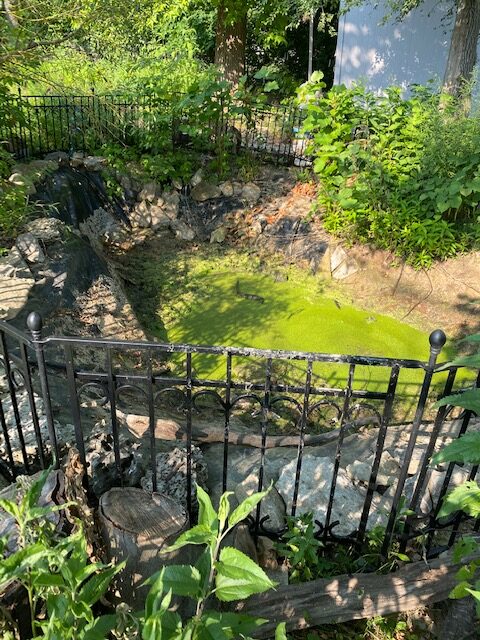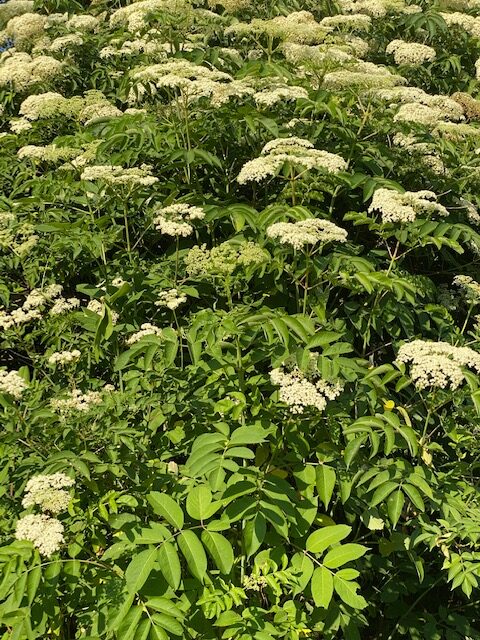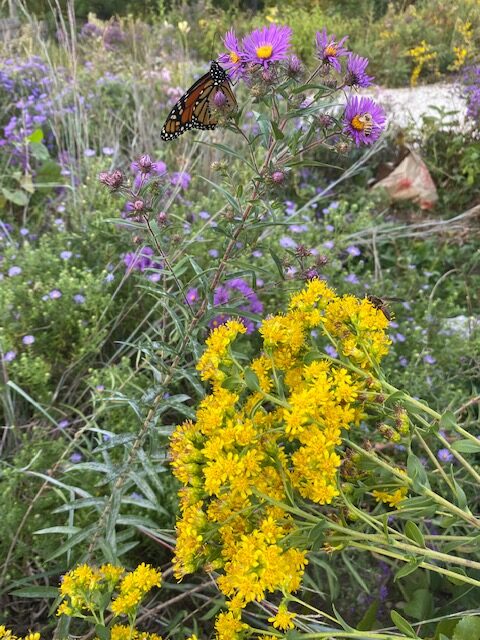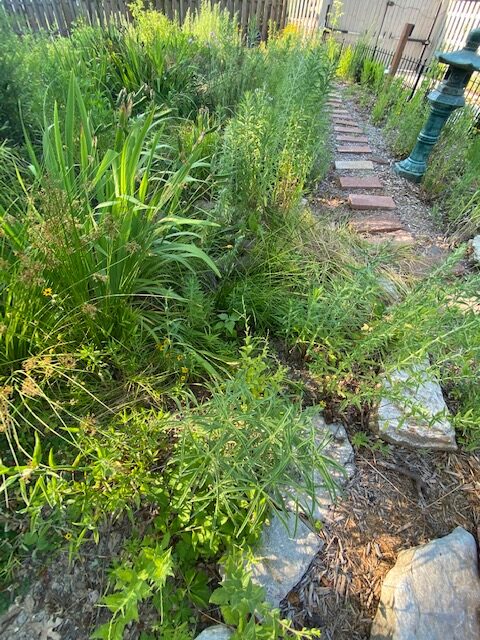If there is one thing certain about Susan and Kei Pang, it is that they are serious about being ecologically friendly, from building a new home for themselves, to creating a native landscape that is home to many insects, birds and other animals.
This is an excerpt from the Wild Ones Journal
Current members can log in to read the latest issue or check out the Journal Archives.
In 2016 the Pangs hired the architect who designed the Mid-America Buddhist Association in Augusta, Missouri to custom design their Creve Coeur, Missouri home, Susan said. “At the outset, we knew that we would build a climate-adapted landscape to match the climate adaptations built into the house like solar and geo-thermal, 2×6 framing with higher R factor insulation, 5/8 drywall throughout and a metal roof to start the journey of the rain being escorted to rain gardens.”
In 2017-18, they started working on their landscaping. “We rented machines for digging trenches and rain garden basins and berms,” Susan said. “We hired someone to operate the equipment and help with the digging, but much of the work we did ourselves.”
A Master Gardener since 2010, Susan said she really started to understand the importance of native plants and habitats after being assigned to the Litzsinger Road Ecology Center. That experience, along with the experience she gained by planting natives at their previous home, helped her to come up with ideas for their Creve Coeur property.
The biggest difference at their new home is that she didn’t have to rip things out. “The bulldozer did that,” she said.

Reading articles about native landscaping and becoming a Wild Ones member helped fill in her knowledge about things she didn’t know.
But she knew one thing: “Every landscape is unique, and every person has different experiences,” Susan said.
The Pangs also knew there were things they didn’t want on their property, such as an irrigation system, which they had at their previous home. That, she said, was an “ordeal,” dealing with maintenance.
Pang said she always had a plan in her head for their landscape. “I just knew how it was going to work, but I never wrote it down.”
At first her husband Kei didn’t understand her passion for natives and why they were doing what they were doing. But now he understands and has done “a lot of shoveling and digging” to convert their property into a paradise for pollinators, insects and other animals, Susan said.
Their own property is just a little shy of 1 acre, but they also care for the property of a neighboring garden chapel, bringing their total bit of heaven to 3 acres.
“Our native plant area is the entire property plus several acres behind our home where we managed to eradicate a 50-year infestation of bush honeysuckle over the course of several years,” Pang said. They hired someone to “root dock” the several acres because “it was the healthier way to protect the animals and desirable plants we wanted to keep,” she said. “Even with the bush honeysuckle, there was still some neat plants worth preserving like sassafras and elderberry.” For others dealing with invasives, Pang recommends they have realistic expectations.
“Our philosophy is that when we get rid of something, we aggressively and abundantly plant and seed the area and keep it up,” she said. “In our situation, the best natives to plant were things that grow like honeysuckle, such as elderberry or sumac. They sucker and shoot out rhizomes … and have a huge roots web under the ground.”


That heavy abundance helps to keep the plant or plants you don’t want at bay, she said. Still, she does a honeysuckle sweep one or two times a year to get rid of the few plants that somehow survive.
Pang said their landscaping follows the lay of the land.
“Our house sits higher than the downward sloping majority of the land, so this naturally lent itself to rain gardens,” she said. “The rainwater is channeled off the metal roof, into the gutters, downspouts and under the pavement to three basins. The higher ground consists of a drought-loving prairie and there are woodlands on the periphery. Also, we put in a special area that I call a permaculture area where garden and food scraps are fed to composting worms, eliminating the need for excessive landfill waste.”
Pang said she learned about permaculture in 2018 while studying in Guatemala for five weeks. “Being immersed in it got me interested in it… and made me realize how important it is to reuse resources like coffee grounds and to make compost with table scraps.”
She said you don’t need to spend a lot of money to do it — you can use old trash cans – and you’ll find it turns into beautiful black soil without doing much.


Pang said she also asks neighbors if she can have their leaves, which she uses for composting. “I always leave the leaves and have never raked, and just allow them to decompose.”
She’s also placed signs on her property to educate her neighbors and others that her property has native plant gardens. Again, it helps people to understand her landscape is intentional, she said.
People new to native landscaping should join like-minded organizations, Pang recommended. “We’re fortunate that in the St. Louis area we have many organizations like the Sustainable Backyard Network, St.
Louis Audubon Bring Conservation Home, Shaw Nature Reserve, Grow Native and the Missouri Prairie Foundation, Master Gardener and Master Naturalist programs … and of course Wild Ones is a national organization with many opportunities to continue learning.”
These groups not only help with learning, but many also offer seed swaps or hold plant sales, allowing you to save money, she said, as you transform your property.
Lastly, Pang recommends people read books about natives, such as “Garden Revolution by Larry Weaner.
While the Pangs belong to the St. Louis Chapter of Wild Ones, they also spend time in other states that have chapters and are even starting a seedling chapter in South Dakota where they own land.
“The whole state doesn’t have a Wild Ones chapter,” Pang said. “We spend a significant amount of time there, so we are trying to build a community of people to start a chapter. I’ve done projects there for fun, such as putting bat boxes in the Whitney Preserve, but I know if I put my heart and soul into this, we could really get it going.”
Susan said she feels nature rewards us, and she wants others to experience that same feeling.
“I feel like we’re doing something for nature, and doing a lot for ourselves,” she said. “Native landscaping is a spiritual experience for me.”
For instance, Pang said she has many bees in their yard, but she’s never been stung by one.
“If you become comfortable in your garden, then the garden becomes part of you,” she said. “I’m part of that landscape and that landscape is part of me.”
About the garden
- Susan and Kei Pang’s property is located in Creve Coeur, a suburb of St. Louis, Missouri. The city derives its name from Creve Coeur Lake, which is shaped like a broken heart.
- Their property is home to lots (hundreds or perhaps thousands) of native plants and has earned St. Louis Audubon Society’s Home Silver, Gold and Platinum honors. It includes three rain gardens, a frog pond, a prairie, woodlands and a permaculture area.
- Susan’s favorite wildflower is wild quinine (Parthenium integrifolium) because the white flowers bloom for quite a long time and the foliage is large and bold. But she also likes prairie dock (Silphium terebinthinaceum) and purple poppy mallow (Callirhoe involucrata). She says: “Basically, it is hard for me not to love most plants as I get to know them and see their wonders up close, after spending years watching them grow and seeing the butterflies, moths, birds and insects they attract. It is gratifying to see finches eating the seeds from coneflowers and even from sweetgum trees!”
- The Pang yard is often visited by monarchs, hawks, owls, fox, deer, wild turkey, squirrels, tree frogs, toads, many kinds of song birds and insects including bees and spiders.
Written by Barbara A. Schmitz.

